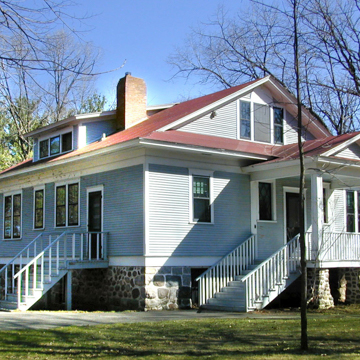In 1898 Charles A. Lindbergh Sr. (1859–1924), sometime prosecuting attorney for Morrison County, Minnesota, purchased 110 acres south of Little Falls with a steep bluff overlooking the Mississippi River. Three years later, having married Evangeline Land of Detroit, he built a cabin there, soon followed by a two-story house for his family. Charles A. Lindbergh Jr.—the future famous aviator—was born in Detroit in 1902 and brought home to Little Falls in the first few weeks of his life.
The two-story house burned in 1905, and in 1906 builder Carl Bolander and a mason named Chilton built the present one-and-a-half-story frame house on the surviving rubble masonry foundation reusing the original brick chimney. In November 1906, Charles Sr. was elected to the U.S. House of Representatives, where he served from 1907 to 1917. For those ten years, the family spent most winters in Washington, returning in summer to the “Camp,” as they called the uninsulated and unheated house in Little Falls.
This name fits the modest dwelling, which, with its humble red rolled roofing, has the familiar feel of a vernacular lake cabin, even as its composition and details are informed by Arts and Crafts sensibilities and neoclassical traditions. On the west, the moderately classicizing porch mediates between rustic, battered rubble piers (reconstructed from historic photographs) and a Palladian pedimented window, while the diaper-muntined windows framing the entry contribute grace rather than pretense. Particularly meaningful to Charles Jr., and among his earliest memories, was the view of the river from the windows and the broad sleeping porch on the southeast corner, reached from the dining room, where he recalled that even in winter “no matter how cold it was…I would sleep on the screened porch overlooking the river. There I was in close contact with sun, rain, wind, and stars.” The main floor included a front hall, kitchen, dining room, parlor, bathroom, master bedroom, Evangeline’s sewing room, and guest room for her mother, who would often visit during the summer.
In 1917 a furnace was installed, and the house was weatherized for year-round use, but in 1919 the farm was turned over to tenants, and Charles Jr. visited only briefly during and after 1920. After his famous 1927 transatlantic flight from Roosevelt Field on Long Island to Le Bourget Field in Paris, souvenir hunters broke into the vacant, boarded-up house and damaged it severely. To protect the house, the family gave it to the State of Minnesota in 1931, a gift that included all 110 acres of land. The 1936–1941 development of the State Park, including restoration of the house, was one of the first WPA projects in Little Falls.
Towards the end of his life, in 1966, 1969, and 1971, Lindbergh revisited the site with Minnesota Historical Society (MHS) staff. While there, he provided useful information for the restoration of the house and landscape, and offered reminiscences that were published by MHS in 1972 as Boyhood on the Upper Mississippi. The Lindbergh House was listed on the National Register of Historic Places in 1970, and became a National Historic Landmark, along with 17 acres of the site, in 1976. Charles A. Lindbergh Jr. died in 1974. Further restoration of the house took place in 1983 and 2000–2004.
References
Grossman, John, “Lindbergh, Charles A. State Park and Lindbergh House,” Morrison County, Minnesota. National Register of Historic Places Inventory-Nomination Form, 1970. National Park Service, U.S. Department of the Interior, Washington, DC.
Lindbergh, Charles A. Boyhood on the Upper Mississippi: A Reminiscent Letter. Saint Paul: Minnesota Historical Society, 1972.
MacDonald and Mack Partnership. “Historic Preservation Plan: Charles A. Lindbergh House, Little Falls, Minnesota.” Minneapolis, 1980.
Martin, Frank Edgerton. “Cultural Landscape Preservation and Interpretation.” In The Building Preservation and Lower Trail Restoration Project at the Charles A. Lindbergh Historic Site. Taylors Falls, MN: Claybaugh Preservation Architecture, 2014.
“Charles A. Lindbergh Historic Site / Restoring Home.” Minnesota Historical Society. Accessed November 10, 2016. http://sites.mnhs.org/historic-sites/charles-lindbergh-historic-site/restoring-home.














